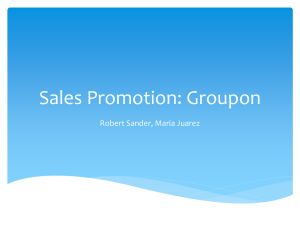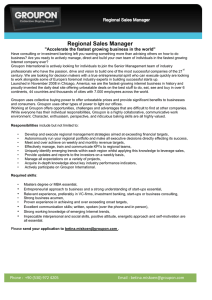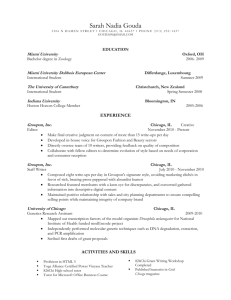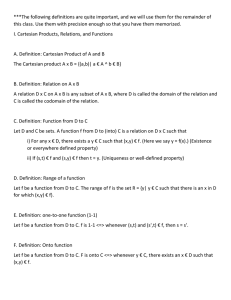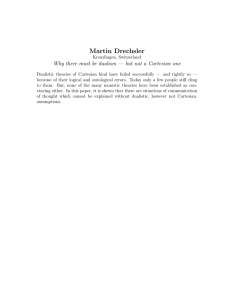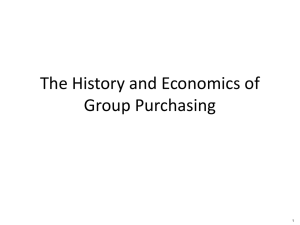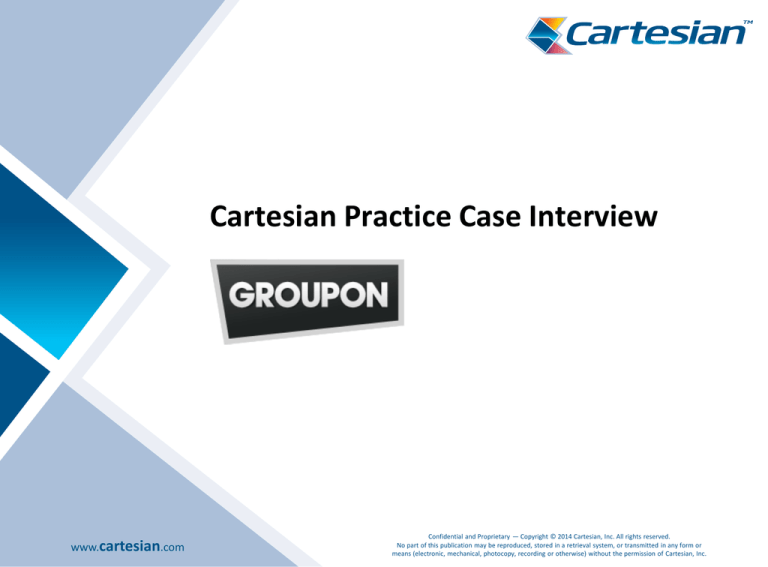
Cartesian Practice Case Interview
www.cartesian.com
Confidential and Proprietary — Copyright © 2014 Cartesian, Inc. All rights reserved.
No part of this publication may be reproduced, stored in a retrieval system, or transmitted in any form or
means (electronic, mechanical, photocopy, recording or otherwise) without the permission of Cartesian, Inc.
In this practice case, we will give you an opportunity to see the types of
questions we ask in case interviews and what we’re looking for.
Today, we’re going to talk about Groupon.
Groupon Overview
How It Works
• A business offers a steeply discounted deal, usually
in one of two forms
– A dollar / gift certificate discount (e.g., $10 for
$20 worth of food)
– A heavily discounted item or service (e.g., $50 for
a $100 massage)
• Groupon splits the revenue from the deal with the
business , usually 50-50
– If the deal costs $100, Groupon gets $50 and the
business gets $50
• For the user, the Groupon is “use it or lose it” –
must use entire value of Groupon at that time
• The business can set a minimum number of deals
sold and an expiration date for the Groupon
Groupon negotiates big discounts –
usually 50%-90% off – with popular
businesses, then offers these daily deals
to a massive user base via a
daily digest email
Founded in:
Revenues (2013):
November 2008
Est. $2,600 M
This online case is not intended to mirror precisely a 30-45 minute in-person case
interview, but rather is meant to probe the same type of thinking and analysis we
expect from you. So please, don’t worry if this takes you longer. Take your time
thinking through the questions. We hope you find the exercise helpful.
Confidential and Proprietary — Copyright © 2014 Cartesian, Inc. All rights reserved.
2
Question 1
Why might a business choose
to run a Groupon deal?
Turn to the next page for Cartesian
answers and explanation
Confidential and Proprietary — Copyright © 2014 Cartesian, Inc. All rights reserved.
3
Question 1: Cartesian Answer
Cartesian Answer
1
What We’re Looking For
Advertising
To raise awareness generally; to
inform customers of new products
or locations; to launch a promotion;
or for any number of other reasons.
Market Share
Capture
A business may think that if they can
get customers in the door, they can
keep them for much longer. This
works well in industries that typically
have low levels of switching and
shopping around.
2
3
Some companies get lots of business
during certain times of year and very
little during others. A Groupon might
help drive sales in off-peak periods to
cover fixed costs.
Seasonality
Offset
4
A Groupon might entail a heavy
discount but, if it’s profitable, could
still be worth it. Groupons offer
vendors the ability to pricediscriminate while protecting
standard pricing.
Revenue
Generation
Turn to the next page for Question 2
Confidential and Proprietary — Copyright © 2014 Cartesian, Inc. All rights reserved.
4
• Issue Identification: Can you apply
general business thinking to
identify the key drivers that might
motivate a business to participate
in a Groupon deal? It’s okay to
start work from specifics to
generalizations or vice versa.
• Structure: Set up your response in
an organized fashion. Feel free to
take a moment to structure your
thoughts on paper before
answering the question.
• Communication: Be clear, cogent,
and persuasive. Try to keep
responses short, saying just what
needs to be said.
• Poise: Be prepared to come up with
a more than these four – and try
not to get intimidated if the
interviewer keeps asking you for
more ideas.
Question 2
How should a business determine
whether or not to run a Groupon?
a) What are the key factors to consider?
b) Walk through the calculation of determining
whether or not a Groupon deal is worth it. Feel
free to come up with your own numbers, but be
sure to have rationale for why you chose them.
Let’s take a pizza shop as an example.
Turn to the next page for Cartesian answers and explanation
Confidential and Proprietary — Copyright © 2014 Cartesian, Inc. All rights reserved.
5
Question 2a: Cartesian Answer
Cartesian Answer
$
$ $$
$ $ $
What We’re Looking For
• Business’ Cost Structure: What are the variable costs associated
with making the pizza relative to the revenue derived from
every slice? If they’re relatively high, it may be hard for a
restaurant to justify giving a steep discount and a 50% cut to
Groupon. If they’re low, the business may be willing to take a bit
of a hit on the margin in exchange for publicity and the
potential for future repeat customers.
• Est’d % of Customers that Will Return at Full Price: Does the
pizza shop think it can convert Groupon customers into fullprice buyers after the fact? How many? This will contribute to
whether it can recoup the costs of offering the Groupon.
• Breakage: This is a term used to describe the number of people
who buy the deal but never redeem it. For the restaurant, this is
just free money. The more breakage, the better.
• % that Underspend/Overspend: Can the restaurant structure
the Groupon in such a way that customers may be likely to
spend more or less than the dollar amount of the Groupon? In
either case, the restaurant benefits.
• Bonus: Which scenario is better for the restaurant?
Underspending or overspending?
Confidential and Proprietary — Copyright © 2014 Cartesian, Inc. All rights reserved.
6
• Issue Identification: Can you
identify the key drivers that will
affect the economics of a
Groupon deal? Do you
understand the basics of the deal
structure? The fundamentals of a
generic business (e.g., variable
costs and relationship to
revenue)?
• Problem Structuring: Can you
take these key factors and
explain how they relate to the
decision-making process, like
which outcomes would be better
or worse for the business in
question and why?
Question 2b: Cartesian Answer (Part 1 of 4)
Cartesian Answer
Overall Breakeven Calculation: On the whole, the business will look at two factors – revenue and
cost – to determine the profitability of running the Groupon. First, we identify the components that
make up revenue and cost, then solve for these components on the following slides.
Revenue
Cost
Total revenue derived –
directly and indirectly – from
running the Groupon
Variable cost. We’ll express
this as a % of the revenue /
retail value of the goods sold
As a % of
Deal Revenue
The portion of the
Groupon
deal/price that
actually goes to
the restaurant
Overspend
Revenue
Follow-On
Revenue
Base Retail
Value
Underspend
Retail Value
Overspend
Retail Value
Revenue resulting
from people who
spend more than
the value of the
Groupon (at the
time they redeem
the Groupon)
Revenue resulting
from people who
come back after
using the Groupon
and pay normal
price
Retail value of
goods bought
using Groupon
Retail value of
Groupon “dollars”
not spent. (This is
essentially a
negative value.)
Retail value of
goods sold above
and beyond
Groupon deal
from overspend at
the time of the
deal redemption
Confidential and Proprietary — Copyright © 2014 Cartesian, Inc. All rights reserved.
7
Follow-On
Revenue Retail
Value
Retail value of
goods sold to
people who come
back after using
the Groupon and
pay normal price
Question 2b: Cartesian Answer (Part 2 of 4)
Cartesian Answer
# Deals Sold
10,000
$10
X
Groupon Share
Assume you’re selling
$10 for $20 worth of
food
Terms of the deal
% of People Who
Overspend
# of People that
Redeem
Avg. Amount
Overspent
X
8,000
X
Also open to
interpretation. That
same Rice study found
that ~80% of buyers
redeem their deals
Probably not by much
given the deal is so
cheap and this is a
pizza shop
% of Customers that
Will Return
# of People that
Redeem
Avg. Amount per
Visit
20%
Up for argument. 20%
on average according
to Rice study
X
8,000
From above
X
$20
Assuming the deal is
priced reasonably, it’s
probably close in $
amount (maybe +/10% or 20%)
= Assumption
Confidential and Proprietary — Copyright © 2014 Cartesian, Inc. All rights reserved.
Overspend Revenue
$8,000
Avg. # Visits
X
1
Will depend on the
period you want to
consider. Over next
year? Lifetime of
business?
= Calculation
8
$50,000
=
$5
A Rice University
study found that
~35% people
overspend. Just pick
something reasonable
Deal Revenue
=
50%
Assumption. Pick an
easy number that’s in
the ballpark
20%
Revenue
X
Deal price
Follow-On Revenue
=
$32,000
Total Revenue
$90,000
Question 2b: Cartesian Answer (Part 3 of 4)
Cartesian Answer
# of People that
Redeem
Retail Value of Goods
8,000
Retail Value of Deal
X
=
$160,000
Assumed on previous
page
Terms of the deal
Retail value of goods
bought using Groupon
# of People that
Underspend
Avg. Amount
Underspent
Underspend Retail
Value
1000
X
Assumption – up for
debate
30%
Variable cost expressed as
percent of revenue / retail
value of goods sold
=
-$2.50
-$2,500
Consider as negative
number
Retail value of goods sold above and
beyond Groupon deal – from
overspend at the time of the deal
and follow-on business (derived on
previous slide)
Cost of Goods Sold
(COGS) as % of Revenue
Cost
$20
Base Retail Value
X
Retail value of Groupon
“dollars” not spent
Overspend Retail
Value
Follow-On Revenue
Retail Value
$8,000
$32,000
Total Retail Value of
Goods Sold
=
$197,500
Total Cost
$59,250
Sum of Base Retail Value,
Underspend Value,
Overspend Value, and
Follow-On Value
Multiply 30% by Total Retail Value
of Goods Sold. Does not include
fixed costs (e.g., rent, staff)
= Assumption
Confidential and Proprietary — Copyright © 2014 Cartesian, Inc. All rights reserved.
• First, we find the total
retail value of goods sold
as a result of the deal (first
3 rows)
• Then we solve for the cost
to deliver those goods
(bottom row) – assume it
as a percent of the retail
value of the goods and
multiply through
= Calculation
9
Question 2b: Cartesian Answer (Part 4 of 4)
Profit/Loss
Cartesian Answer
Total Revenue
$90,000
Total Cost
–
$59,250
What We’re Looking For
=
Total Profit/Loss
$30,750
Bonus:
What if the deal resulted in a net loss for the business? Could it still be
justifiable? How? (Hint: think back to Question 1)
Other factors to consider might be
• The number of customers that bought the Groupon that were not new
(e.g., regulars) and therefore might have come in anyways and paid full
price had the Groupon not been available
• Brand impact
• Impact on other customers (e.g., angering other customers due to
Groupon-induced overflow)
The ability to identify – and better still, to quantify – these factors would take
your answer from good to great. How might you account for these?
Turn to the next page for Question 3
Confidential and Proprietary — Copyright © 2014 Cartesian, Inc. All rights reserved.
10
• Problem Structuring: Can you
take the factors discussed in the
previous question and clearly set
up how where they fit into
calculation?
• Quantitative Facility: Are you
comfortable with numbers? Can
you do the basic math with
relative facility? Don’t be afraid
to take out your pencil and
paper.
• Basic Rationale: You’ll be asked
to come up with your own
numbers. No one expects you to
be a business expert, but are
your numbers reasonable? Can
you defend them?
Question 3
Based on the outcome of Question 3,
what types of businesses and what types of deals
are best-suited to the Groupon model?
Turn to the next page for Cartesian answers and explanation
Confidential and Proprietary — Copyright © 2014 Cartesian, Inc. All rights reserved.
11
Question 3: Cartesian Answer
Cartesian Answer
REVENUE
Business Types
COSTS
Deal Types
$$ $
Example
• Low Variable Cost as % of Revenue: This is a key driver of deal
profitability. Businesses with low costs relative to revenue can
support a steep discount and the 50% payout to Groupon.
Bonus: An excellent answer might include a discussion of the
balance between fixed and variable costs. If a business has really
high fixed costs, how might that impact its interest in sacrificing
on the margin through the use of a Groupon?
Business that offer
recreational
activities (e.g.,
skydiving), events
(e.g., sports,
concerts), and
gyms
• Encourage Breakage: Deals with aptly planned expiration
dates will drive breakage up and redemption down – free
money for the business, since it incurs no cost. By the same
token, businesses do need to consider potentially negative
impacts on customer perceptions/satisfaction.
Business gives 1month window for
a promotional
Groupon
• Encourage Overspending: Carefully priced deals will incent
customers to spend more than the value of the Groupon.
While underspending is good for the business, too, don’t
forget that the business still incurs a higher cost on these
dollars given the discount on the deal and the payout to
Groupon. For this reason, overspending is preferable.
Restaurant knows
average check
price is $50, so
offers Groupon for
$40 worth of food
• Encourage Follow-On Business: The Groupon and customer
experience ought to be designed in such a way that customers
leaves feeling like they want to come back, and even better,
tell their friends. That is where the business will end up
making money in the long run.
Business makes
concerted effort to
ensure Groupon
experience is
positive, asks for
feedback, etc.
Confidential and Proprietary — Copyright © 2014 Cartesian, Inc. All rights reserved.
12
What We’re Looking For
• Synthesis: Can you take all
the information we’ve
discussed in the previous
questions and tease out
the key takeaways? Do you
understand the higherlevel implications of the
issues previously
discussed? Can you
summarize these
takeaways in a structured
and cogent manner? Once
again, it’s okay to start
work from specifics to
generalizations or vice
versa
Turn to the next
page for some final
words of advice
Next Steps
Practice
Practice
Practice
Confidential and Proprietary — Copyright © 2014 Cartesian, Inc. All rights reserved.
13
Two Financial Center
60 South Street, Suite 820
Boston, MA 02111
USA
7300 College Blvd
Suite 302
Overland Park, KS 66210
USA
Descartes House
8 Gate Street
London WC2A 3HP
UK
www.cartesian.com
400 Atrium Drive
1st Floor
Somerset, NJ 08873
USA
8260 Greensboro Drive
Suite A-30
McLean, VA 22102
USA
Confidential and Proprietary — Copyright © 2014 Cartesian, Inc. All rights reserved.
14

